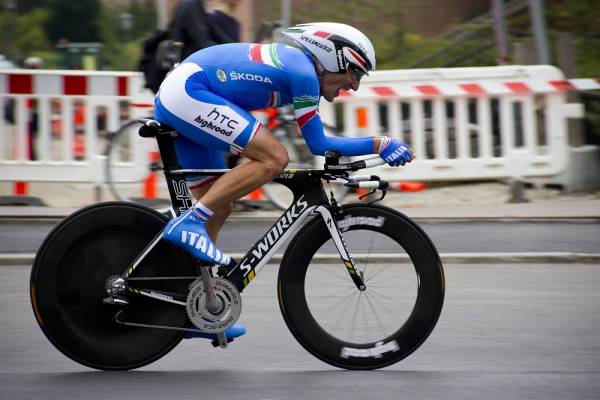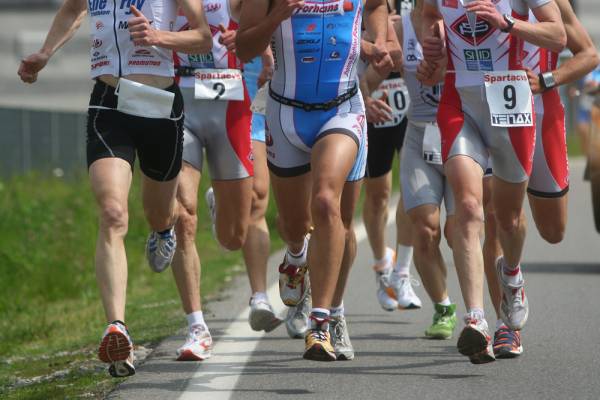While all athletes are a little crazy, I’ve yet to meet any single group that will jump on anything to make themselves faster like a triathlete will. Their sheer determination to go faster, even if it means looking ridiculous, sets them apart as kings of the type-A hill.
With the proliferation of mountains of carbon parts and other go-faster gear, a triathlete could end up very broke very fast if they tried to keep up in the arms race of chasing speed though spending. And it’s here that Jim Gourley’s book, Faster: Demystifying the Science of Triathlon Speed, steps in. Gourley has a pretty interesting background – he’s literally a rocket scientist. Since helping launch a satellite into space he’s gone on to write for many well-known triathlon magazines including Lava, Inside Triathlon and Triathlete. His new book is a look at the actual science involved in going faster and points out some of the biggest fallacies regarding bikes and expensive parts, run technique, and even overall pacing strategies, all based on scientific research of racers.
The book begins with a short review of some of the physics mentioned in the book, and I have to say I had nearly exhausted my entire understanding of the subject by page five. That left me wondering just how much more complicated it was going to get. Gourley’s an intelligent guy, and the companies involved in bike and wheel manufacture are using similar guys to build and market their products, so I knew it was going to get even more detailed. But I needn’t have worried – at no point did I feel overwhelmed by the science being discussed. One of the great signs of someone who truly understands their subject is their ability to explain it succinctly and simply. Gourley does that throughout this entire book, discussing concepts like different types of drag, coefficients of friction, and even power production and heat management.
Part 1: The Swim
After the short introduction chapter on basic science, the book starts where all races start – the swim. Gourley begins talking about concepts like drag and explains how various shapes make us more streamlined in the water. There are two massive standouts in this chapter for me. The first is that while a fish is 80% efficient moving through water, an elite swimmer is 61%, and a triathlete is only 44% efficient. What that says to me is that the biggest gains in swim speed for a triathlete will come from focusing on technique.
That ties into the second standout point for me – swimming the start of a race at over 85% of your maximum for that distance will lead to a blow out later on, irrespective of distance. Studies show that as intensity on the swim increases, not only does power output on the bike decrease, but that athletes who swam at 80-85% had an overall race time 1:45 faster over the course of a sprint triathlon. (750m swim, 20km ride, 5km run). Expanded over an Ironman distance event, that gap grows massively and could well be the difference between qualifying for Kona and just missing out. Gourley suggests the best way to achieve this reduction in effort is to drag off another swimmer. The best position is about one meter to the side of another swimmer in a position so that your extended hand comes level with their shoulder as it enters the water.
Part 2: The Bike
 Any triathlete will salivate over the prospect of getting some insider science tips on how to go faster on the bike. In any race you will spend more time on the bike than on the other two portions. Improving your performance by a few percent here makes a bigger time difference than it will anywhere else. In a sport filled with carbon bits and pieces, deep rim and disc wheels, aerodynamic helmets, and any other piece of go-faster kit you can imagine, it’s natural that a newcomer wouldn’t know what is a worthwhile investment and what isn’t.
Any triathlete will salivate over the prospect of getting some insider science tips on how to go faster on the bike. In any race you will spend more time on the bike than on the other two portions. Improving your performance by a few percent here makes a bigger time difference than it will anywhere else. In a sport filled with carbon bits and pieces, deep rim and disc wheels, aerodynamic helmets, and any other piece of go-faster kit you can imagine, it’s natural that a newcomer wouldn’t know what is a worthwhile investment and what isn’t.
Gourley fixes that succinctly by naming the power meter as the single best piece of kit you can buy for your bike. His reason, as it is all through the book, is based on common sense. A bike alone is not fast. Without a human being pedalling, there would be no movement at all. So what makes a bike fast is the rider. He likens a bike on its own as being like a Ferrari without an engine – you are the engine. The bike typically makes up about 30% of the total aerodynamic resistance while moving, and less than 15% of the total mass of the rider-bike combination.
The reason that a power meter is so important then is that it allows you to precisely train at specific efforts as well as paces during a race. As far as value for money goes, the power meter is an item that can be used in every training session, as opposed to expensive carbon wheels you will only pull out for races. And speaking of those wheels how much of a saving can you expect to get from them?
Gourley’s basic rule for whether or not an item will be a worthy investment is if it saves you ten watts or more – measured, of course, by your power meter. A ten watt saving is worth up to a minute over the ride of an Olympic-distance race (25mi or 40km). As an example, he compares an aluminium bike to one decked out in all kinds of carbon goodness. The total weight saved is about 1.5kg or 3.2lbs. To get to the point where a ten-watt difference becomes apparent, you need to be riding up a hill above ten-percent gradient and producing in excess of 400 watts. (For the record, the winner of the ironman World Championships last year averaged 281 watts, and peaked at 645 watts during a move to the front of the pack and at the start of the climb to the bike turnaround. But that’s the best guy in the world, and on a road much less than a ten percent grade. So how much do you need a lighter bike versus a more powerful engine?)
Along with the discussion on power and how you should be using it all the time, the next biggest revelation regarding the bike was on aerodynamics. A rider on a time trial bike, who stays in the aerodynamic position, saves 15% effort over a rider in a typical road bike position. So after a power meter the second thing you need to buy is a good bike fitting session to ensure you can stay aero for the entire bike leg. After that a good aerodynamic helmet will save you far more than an expensive set of wheels. Yes, even more than an uber-sexy disc. And when you look at the costs involved, the wheels cost far more yet give far less benefit. Much better to spend money on a power meter, bike fit, and decent helmet in terms of speed for dollars.
Part 3: The Run
 Finally, onto the run. In this section the biggest thing I learned was that the majority of forces I have to struggle with while running are not horizontal, despite the fact that I am running forwards. The majority of forces are vertical. Studies done on elite runners show that their vertical displacement is less than 7.5cm from the ground on each stride. That’s about three inches. Next time you go run, take a note of how high you step each time, and then realize that for every little bit higher you step, you are forced to deal with far more force on the return to earth. That means you’re going to tire your legs out more and more and that will increase the amount of contact time on the ground. And this final part is very important – the higher you go in the air, the more energy you need to expend landing, decelerating, accelerating, and taking off from the ground again.
Finally, onto the run. In this section the biggest thing I learned was that the majority of forces I have to struggle with while running are not horizontal, despite the fact that I am running forwards. The majority of forces are vertical. Studies done on elite runners show that their vertical displacement is less than 7.5cm from the ground on each stride. That’s about three inches. Next time you go run, take a note of how high you step each time, and then realize that for every little bit higher you step, you are forced to deal with far more force on the return to earth. That means you’re going to tire your legs out more and more and that will increase the amount of contact time on the ground. And this final part is very important – the higher you go in the air, the more energy you need to expend landing, decelerating, accelerating, and taking off from the ground again.
The solution to this is to run at a cadence of 180-190 steps per minute. Studies on this show that it decreases contact time on the ground by 32%, reduces vertical force displacement by 76%, and increases leg stiffness (how efficiently your legs are working in terms of absorbing and then redirecting the energy to keep you moving forward) by 100%.
The takeaway from the entire book is that pacing becomes important from the moment you get in the water. Swim too fast and risk slower times on the bike and run. Ride too fast and risk tired legs on the run. The use of a power meter at all distances beyond a sprint race will help to ensure you leave T2 as fresh as possible.
Overall, I thought Faster was a great read. It’s given me a lot to think about in terms of my own training. I think that any triathlete who is either racing for a front of the pack finish or just working to be the best they can be would enjoy this book immensely. It puts complicated science in terms that are easy to understand and then links it back to purchasing decisions. This is probably the best thing about the entire book. Triathlon can be an expensive sport, and people often feel like they need the latest and greatest to compete, but that isn’t the case as the Gourley explains quite clearly via research and science. Not only that but he has a great sense of humour and takes the boringness out of what could be an incredibly dry topic.
“Faster: Demystifying the Science of Triathlon Speed” is available for $14.60 at Amazon.com.
Photos courtesy of Shutterstock.






